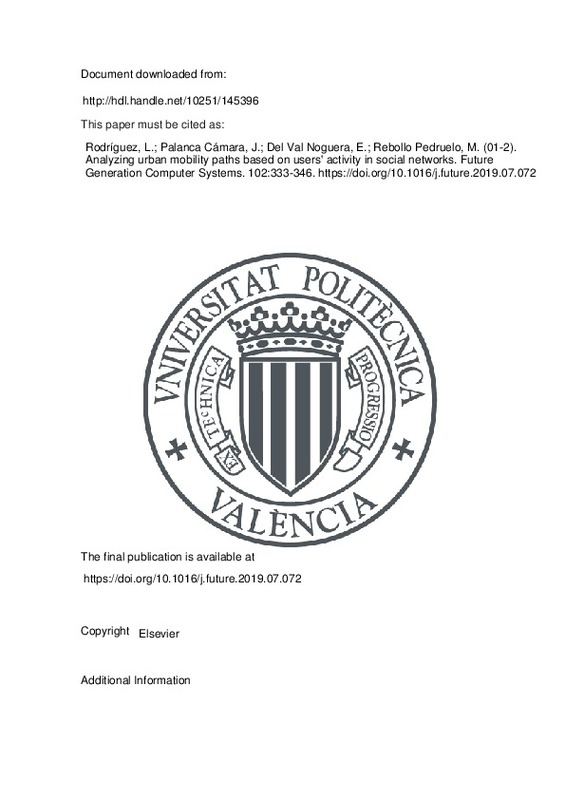JavaScript is disabled for your browser. Some features of this site may not work without it.
Buscar en RiuNet
Listar
Mi cuenta
Estadísticas
Ayuda RiuNet
Admin. UPV
Analyzing urban mobility paths based on users' activity in social networks
Mostrar el registro sencillo del ítem
Ficheros en el ítem
| dc.contributor.author | Rodríguez, L.
|
es_ES |
| dc.contributor.author | Palanca Cámara, Javier
|
es_ES |
| dc.contributor.author | Del Val Noguera, Elena
|
es_ES |
| dc.contributor.author | Rebollo Pedruelo, Miguel
|
es_ES |
| dc.date.accessioned | 2020-06-05T03:32:11Z | |
| dc.date.available | 2020-06-05T03:32:11Z | |
| dc.date.issued | 2020-01 | es_ES |
| dc.identifier.issn | 0167-739X | es_ES |
| dc.identifier.uri | http://hdl.handle.net/10251/145396 | |
| dc.description.abstract | [EN] This work presents an approach to model how the activity in social media of the citizens reflects the activity in the city. The proposal includes a gravitational model that deforms the surface of the city based on the intensity of the activity in different zones. The information is extracted from geolocated tweets (n = 1.48 x 10(6)). Furthermore, this activity affects how people move in a city. The path a user follows is calculated using the geolocation of the tweets that he or she publishes along the day. Several models are evaluated and compared using the Hausdorfs distance (d(H)). The combination of gravitational potential with attraction to the destination points provides the best results, with d(H) = 1176 against the Manhattan (d(H) = 1203) or the geodesic (d(H) = 1417) alternatives. Finally, the analysis is repeated with the data segmented by gender (n=2,826 paths, men=1,910, women=916). The results validate (p=0.000334) the studies that affirm that men travel longer distances (d(M) = 4.73 km, alpha(m) = 26.1 degrees) with rectilinear trajectories, whereas women have shorter and more angled paths (d(w) = 4.5 km, alpha(w) = 32.2 degrees), obtaining p values in path lengths and p=0.006 in the angles. (C) 2019 Elsevier B.V. All rights reserved. | es_ES |
| dc.description.sponsorship | This work is partially supported by Spanish Government Project TIN2015-65515-C4-1-R and the Post-doc grant Ref. SP20170057. | es_ES |
| dc.language | Inglés | es_ES |
| dc.publisher | Elsevier | es_ES |
| dc.relation.ispartof | Future Generation Computer Systems | es_ES |
| dc.rights | Reserva de todos los derechos | es_ES |
| dc.subject | Complex network | es_ES |
| dc.subject | Social media | es_ES |
| dc.subject | Mobility | es_ES |
| dc.subject | Gender | es_ES |
| dc.subject | Smart cities | es_ES |
| dc.subject.classification | LENGUAJES Y SISTEMAS INFORMATICOS | es_ES |
| dc.subject.classification | BIBLIOTECONOMIA Y DOCUMENTACION | es_ES |
| dc.title | Analyzing urban mobility paths based on users' activity in social networks | es_ES |
| dc.type | Artículo | es_ES |
| dc.identifier.doi | 10.1016/j.future.2019.07.072 | es_ES |
| dc.relation.projectID | info:eu-repo/grantAgreement/MINECO//TIN2015-65515-C4-1-R/ES/ARQUITECTURA PERSUASIVA PARA EL USO SOSTENIBLE E INTELIGENTE DE VEHICULOS EN FLOTAS URBANAS/ | es_ES |
| dc.rights.accessRights | Abierto | es_ES |
| dc.contributor.affiliation | Universitat Politècnica de València. Departamento de Sistemas Informáticos y Computación - Departament de Sistemes Informàtics i Computació | es_ES |
| dc.description.bibliographicCitation | Rodríguez, L.; Palanca Cámara, J.; Del Val Noguera, E.; Rebollo Pedruelo, M. (2020). Analyzing urban mobility paths based on users' activity in social networks. Future Generation Computer Systems. 102:333-346. https://doi.org/10.1016/j.future.2019.07.072 | es_ES |
| dc.description.accrualMethod | S | es_ES |
| dc.relation.publisherversion | https://doi.org/10.1016/j.future.2019.07.072 | es_ES |
| dc.description.upvformatpinicio | 333 | es_ES |
| dc.description.upvformatpfin | 346 | es_ES |
| dc.type.version | info:eu-repo/semantics/publishedVersion | es_ES |
| dc.description.volume | 102 | es_ES |
| dc.relation.pasarela | S\392601 | es_ES |
| dc.contributor.funder | Ministerio de Economía y Competitividad | es_ES |







![[Cerrado]](/themes/UPV/images/candado.png)

